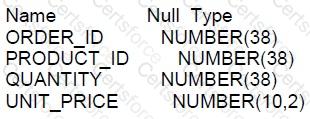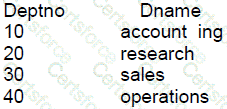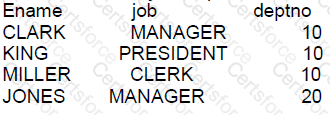The INVOICE table has a QTY_SOLD column of data type NUMBER and an INVOICE_DATE column of data type DATE NLS_DATE_FORMAT is set to DD-MON-RR.
Which two are true about data type conversions involving these columns in query expressions?
The PROD_ID column is the foreign key in the SALES table.Which references the PRODUCTS table.
Similarly,the CUST_ID and TIME_ID columns are Also foreign keys in the SALES table referencing the CUSTOMERS and TIMES tables, respectively.
Evaluate the following CREATE TABLE command:
CREATE TABLE new_sales(prod_id, I cust_id, order_date DEFAULT SYSDATE)
AS SELECT I prod_id,cust_id,time_id FROM sales.
Which statement is true regarding the above command?
Examine the description of the CUSTOMERS table:

You want to display details of all customers who reside in cities starting with the letter D followed by at least two character.
Which query can be used?
Examine this statement:
SELECT 1 AS id, ' John' AS first name
FROM DUAL
UNION
SELECT 1 , ' John' AS name
FROM DUAL
ORDER BY 1;
What is returned upon execution?
Examine this statement:
CREATE TABTE orders
(sarial_no NUMBER UNIQUE,
order_id NUMBER PRIMARY KEY ,
order_date DATE NOT NULL,
status VARCHAR2 (10) CHECK (status IN ('CREDIT', 'CASH')),
product_id NUMBER REFERENCES products (product_id),
order_ total NUMBER);
On which two columns of the table will an index be created automatically?
Examine the description of the ORDER_ITEMS table:

Examine this incomplete query:
SELECT DISTINCT quantity * unit_price total_paid FROM order_items ORDER BY
Which two can replace
Examine these two queries and their output:
SELECT deptno, dname FROM dept;

SELECT ename, job, deptno FROM emp ORDER BY deptno;

Now examine this query:
SELECT ename, dname
FROM emp CROSS JOIN dept WHERE job = 'MANAGER'
AND dept.deptno IN (10, 20) ;
Examine the description of the CUSTOMERS table:

You need to display last names and credit limits of all customers whose last name starts with A or B In lower or upper case, and whose credit limit is below 1000.
Examine this partial query:
SELECT cust_last_nare, cust_credit_limit FROM customers
Which two WHERE conditions give the required result?
Which three items does a direction of a relationship contain?
Examine the description of the PROMOTIONS TABLE:
You want to display the unique is promotion costs in each promotion category.
Which two queries can be used?